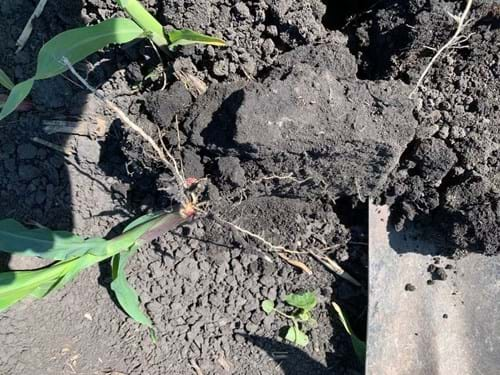Agronomy Update: 2020 Crop Off To A Good Start
BY DAIRYLAND SEED AGRONOMY TEAM
Late Vegetative Crop Development
The 2020 crop is off to a good start and approaching an exciting time of the season. Fieldwork in our corn and soybean fields is about to hit a lull as we wrap up herbicide and nitrogen applications; a great time to sit back and watch rapid development, nearly on a daily basis.
As the soybean crop passes through the V1-3 growth stages, nitrogen fixation kicks in, and we pass that “nervous yellow phase” that always triggers questions and comments from the field. Patience usually prevails and the soybeans turn darker green with just a few root nodules. 30-40 days after emergence, the V4-5 stages coincide with the beginning of rapid growth and biomass accumulation. Flowering also kicks in at this time, lasting for three to four weeks. Since we plant indeterminate soybeans in the upper Midwest, vegetative growth will continue through flowering into full pod or early seed fill.
Our corn fields are also approaching that rapid growth and nutrient uptake phase with a quick run to tasseling. Much of our crop is past the V5 stage when the growing point starts to elevate above the soil surface. This increases susceptibility to environmental risks and is the reason for many of the 12 inch height restrictions on herbicide labels. The number of kernel rows on the ear is developing by the V7 stage and rapid N uptake begins at V8. Are your N applications done? V10-12 is when brace roots develop and is the critical point for establishing the potential number of kernels in each kernel row on the ear. The tassel appears 50-60 days after emergence, the final vegetative stage. Days later, R1 begins with the emergence of silks on the ear shoots.
Stress factors at any of these stages can impact yield according to what is going on in the plant. We have all worked hard to do what we can to reduce stress on our crop to this point, now let’s hope for timely rain and abundant sunshine as Mother Nature takes over!
Tattle Tale Crops
Some years we can get by with a lot of mistakes. Other years everything we did wrong is on display for the whole world to see. This could be one of those years.
Recent hot, dry conditions have highlighted a few issues we have in our fields.
- One we are likely seeing is some carryover of late applied herbicides from 2019 compounded by early planting in 2020.
- Next, we can detect traffic patterns in select fields quite easily this spring. This is yet another possible hold over issue from 2019 and fall tillage performed under wet conditions or 2020 spring tillage. Compaction is almost always associated with those patterns and has added to some of the issues we are dealing with at this time.
- The most recent stretch of heat and moisture stress has rightfully caused some concern especially in those fields already struggling. If we were to select a time for drought stress, this may be the time. Of the yield determining factors, plants per acre is the only real issue at this stage. Are the plants established and ready to grow? We are beginning to enter a critical stage for corn growth as ear girth is being determined.
- Just this week soybeans began to flower. Much needed rains arrived earlier this week over much of the Dairyland Seed footprint. This provided some relief at what is beginning to be the more critical stages in crop physiological growth and the determination of yield.
With the all the growing challenges mentioned above, most fields are getting established now. What once were yellow fields with uneven stands have turned the corner and have a healthy green color. In select instances we needed the corn to reach the Nitrogen already. Yet others we needed to get it side dressed and perhaps add other soil amendments such as Sulphur. Fortunately, we have had a few days for the soil amendments that we applied to take affect and the plants are responding. Yes, your agronomy team did get that one correct! So, let’s keep the “adequate” precipitation coming and harvest a tremendous crop in 2020.

Post-Emerge Weed Control Notes
We are in the thick of post-emergence weed control on soybeans. Here are a few comments, focused especially on the Enlist™ weed control system.
This is the first year of widespread use of the Enlist™ weed control system, and it certainly is timely! The Enlist™ weed control system offers an excellent system in all ways: excellent genetics, very strong agronomic packages on Enlist E3™ soybean varieties, and the most robust weed control system available.
There are many resources available help you utilize Enlist™ weed control system properly. We list several of those resources below and encourage you to take advantage of them.
A couple of comments:
- As you know, weed control has changed drastically since the days of “a quart of glyphosate most any time will do it”. One of the keys to successful Enlist™ weed control system use is to make sure to attack weeds early. Do not “wait another week until canopy closure”; rather, apply post-emerge products at the appropriate weed size for complete weed kill. With the Enlist™ weed control system, you can come back later with another application if needed.
- Know your weed spectrum: What are the primary and secondary weeds you have? With the ability to mix any combination of glyphosate, Liberty, and Enlist™ (2,4-D choline), you can control nearly every weed out there. But it is important to choose the necessary products and get the rates right.
- With the Enlist™ weed control system, do not cheat on the rates. For nearly all situations, use either the full 2 pt rate of Enlist One® or the 4.75 pt rate of Enlist Duo®.
- Do be aware that you may see some temporary impact on Enlist E3™ soybeans: leaf speckling and “droopy leaf” are both possibilities. We have seen more of those symptoms than expected this year, due to the application of herbicide in very hot weather and plants under moisture stress. Weed control has been excellent. The impact on the soybeans is temporary: the beans will be “good as new” in 24-48 hours.
Call us if you have more questions or concerns. The Enlist™ weed control system is THE system going forward. Let’s learn to use it properly and steward the system appropriately.
Resources for Public Use
- Enlist.com – newly redesigned site has tank mix list, all published literature in the new Enlist Ahead section and general Enlist info
- Enlist webinars recordings – see 60 min. on-demand sessions
- Enlist YouTube – Did you know we have 37 best management practices videos? Over the past year, we added dozens of positioning and technical topic videos, as well as grower stories
- Enlist 360 online training – Multiple modules for retail, licensees, and public access
- Enlist Ahead app – download for iOS, access to literature and tank mix list link
Corteva Technology Use Agreements
All growers with orders for any Corteva Agriscience brand seed product, regardless of crop or trait (including non-GM products) need to have a signed Corteva Technology Use Agreement in place by September 1. Growers should sign the Corteva Technology Use Agreement electronically at www.agcelerate.com. Signing electronically is preferable, however, paper copies are available at www.traitstewardship.com.
 |
 |
 |
 |
 |
| Brian Weller Western Region 507.456.3034 |
Dan Ritter Central Region 219.863.0583 |
Branden Furseth Northern Region 608.513.4265 |
Rod King Eastern Region 574.596.6721 |
Terry Jones Eastern Region 419.630.3115 |
